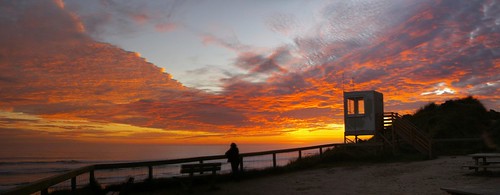Undeveloped ocean beaches like Venus Bay typically have a different shape in summer and winter. Normally in Australia these are called the
Summer Berm and
Winter Berm. At the moment you can see both shapes and we haven't seen a true wide summer berm develop along the beach for several years (possibly 2006/2007 was the last period).
So What is a Summer Berm?
The term Berm has a few different meanings, It can be a mound of earth set up to protect low lying areas behind it (a levy bank). It the USA it often is the name given to a beach or flat river bank or even the edge of road. Any sub level surface will be called a berm but the flat/horizontal part will be called a Bench , the change of slope called the Berm Crest and the sloping front face the Berm Slope.
During summer when the waves and swells are generally calmer the top part of the beach start to dry out and wind action starts to level out the beach changing its gradient and making it flatter. A surprising lot of sand can be moved bu the wind and often extra sand is "stolen" from lower wetter parts of the beach and builts up this top part of the beach. The first sign most of us will notice is a soft sand pile built up at the bottom of the ramp or steps down to the beach.
In winter, storms and pounding winter swells bringing a lot more wave energy to lift and redistribute the sand both on the beach and below the waterline. The shape is now a single gentle curve getting steeper up the beach. Whilst the winds can be stronger in these times the sand is generally very wet so less wind erosion in involved. The winter shape has dominated changes in the Venus Bay beach over the past few years.
I am beginning to suspect the return of the sumer berm is related to the general change to a northwards longshore drift.
It will be interesting to see if the hooded plovers and other shore birds have a more succesful breeding season with a wider upper beach and less risk of nests being washed away.






 the next ones are due now and over the weekend. We get higher tides twice each month corresponding roughly with the
the next ones are due now and over the weekend. We get higher tides twice each month corresponding roughly with the 





![Sand Crab [Ovalipes australiensis] Sand Crab [Ovalipes australiensis]](https://blogger.googleusercontent.com/img/b/R29vZ2xl/AVvXsEgmgTt9YhV5kgK2X0NSWOruzfq8Tt9xoIK8fAu1QOAtgF_rCEJUal8abtYCOBIcOwqchyphenhyphenhQilnrVieBU9cH_HgbMYu8LaHmdqW2dveFiUzlCnI7TLcGx4N6QGZ0CtyrF_x3zwdkOWuJq0g/?imgmax=800)








